Dogs don’t automatically understand how to walk on a leash. That’s a valuable skill you need to teach a puppy.
But dog leash training can be challenging, and new pet parents don’t always know how to leash-train a dog.
Fortunately, we have your back! We’ve put together this comprehensive guide explaining how to train your dog to walk on a leash.
Keep reading to learn everything you need about the fine art of successful, stress-free dog leash training!
Leash Training – Why Bother?
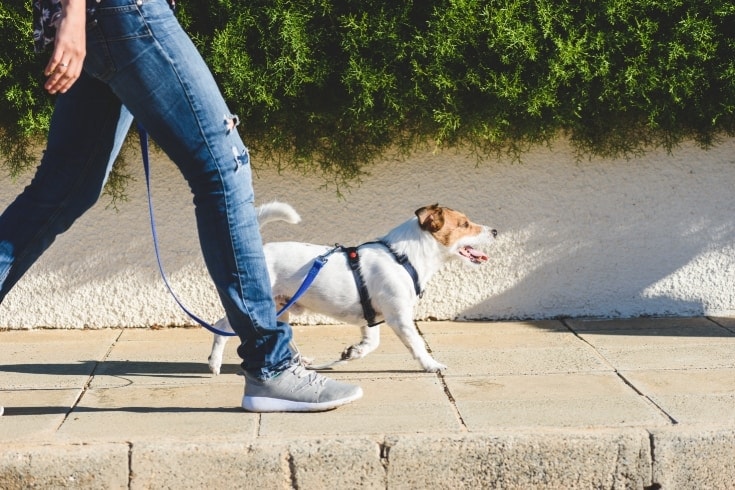
Although leash training might seem like a hassle, having a well-mannered, leash-trained dog offers plenty of benefits.
Easy Walking
If your dog is leash-trained, you’ll find walking him much more pleasurable since your dog won’t tug and pull.
Amazingly, a dog that habitually pulls on his leash can inflict quite serious damage on his handler. At best, you risk pulling muscles and aching joints, while at worst, you could be pulled right off your feet.
Variety
If you like to get out and about to different restaurants, shops, cafes, etc., there are plenty of dog-friendly places you can visit, but only if your furry friend is obedient, calm, and fully leash-trained.
Socialization
Taking a stroll around your local neighborhood can be a great way of socializing a dog or puppy and introducing him to new sights and sounds. However, that’s only possible if your dog is fully leash-trained and obedient.
Exercise Options
The option to walk in an area away from parks and dog parks is essential if you live in a city or if the weather is very wet or snowy and a trip to the park isn’t feasible.
Instead of sitting at home and exercising your pup by playing indoor games, if your dog is leash-trained, you can enjoy walks around your local neighborhood and in parks where on-leash walking is obligatory.
All those benefits are available for dogs that are leash-trained, so now’s the time to get started!
What Leash Training Supplies Do I Need?
Before you begin training your puppy or dog, you need to assemble a range of essential leash-training pieces of kit.
Here’s what you’ll need to buy:
- A correctly fitted dog harness
- A high-quality 6-foot training leash
- Training treats
- Dog poop bags and holder
You’ll find everything you need for leash-training your dog at your local pet store or online. In addition, many vet clinics have some of these items for sale and can be an excellent source of advice.
Retractable Leashes
We don’t recommend using retractable leashes for training your dog. That kind of leash can be confusing for many dogs since it has a constant pulling effect.
Retractable leashes or Flexi-leads can provide some excellent benefits for dogs when used correctly.
The idea behind this type of leash is to provide dogs with the freedom to roam and explore. However, the design can cause issues when used in enclosed spaces, in situations where you can’t pay full attention to your dog, and in areas shared by other pets.
Injury Danger
The super-thin cord of a retractable leash can cause deep lacerations, severe burns, strangulation, and entanglement. In extreme cases, a retractable leash can amputate human fingers and even a pet’s limbs!
If two dogs on retractable leashes become entangled, that’s a potentially dangerous situation for both the dogs and their handlers. Tangled dogs are likely to become afraid, which can increase the risk of leash aggression, bites, and cord injuries when the owners attempt to untangle their pets.
Fatal Accidents
The built-in locks on a retractable leash can fail over time, leaving the dog able to dash out into traffic or attack another dog.
In addition, incidents have been reported where a dog has dashed away from its owner to the full extent of the leash, tugging the large plastic handle from the owner’s grip. The leash has then automatically retracted, sending the handle hurtling into the dog at speed, causing a fatal head injury.
Harness vs. Collar
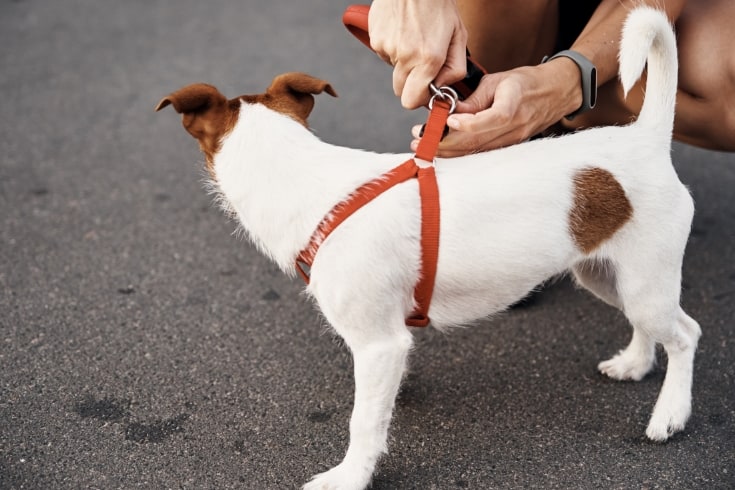
Your dog needs to wear a collar to carry his ID and rabies tags; it’s the law. However, you must always use a high-quality, correctly fitted dog harness for leash training and walking your pampered pet.
How so?
Well, a dog harness is much kinder on your dog’s neck. When I worked in a veterinary clinic, we saw many collar injuries and always encouraged our clients to use a harness for walking their dogs instead of a collar.
When your dog is wearing a collar attached to a leash, the pressure of the collar being pulled back can cause injuries to the dog’s windpipe, thyroid glands, salivary glands, and the tissues in the neck area.
It’s not unheard of for dogs to be strangled by a collar if it becomes snagged on a fence or tree branch. If the collar is too loose, a dog could get a leg caught in the collar.
In contrast, a correctly fitted chest harness places any pressure on the dog’s chest if he pulls back, which is much safer.
Leash Training – Step-By-Step
Now that you have all the necessary equipment, let’s learn how to leash-train your dog in a few simple steps!
Don’t Pull!
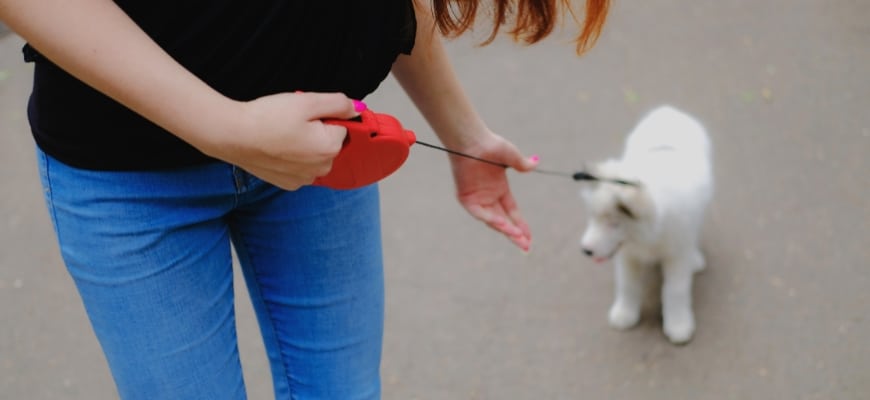
When leash-training your dog, never pull or tug on the leash, even if the process is frustrating.
Leash training is about training your dog to be where you want him to be. Tugging or yanking on the leash can injure your furry friend, so don’t do it! Instead, use positive reinforcement training methods and reward your dog with praise and a treat when he walks obediently alongside you.
Be Patient
Even the most intelligent dog breeds can’t be expected to learn how to walk on a leash overnight!
All dogs have a limited attention span, so keep training sessions short when you’re training your dog or puppy. A few minutes per session is ample for a young puppy, whereas ten to 15 minutes is fine for an adult dog.
Step 1 – Start Indoors
Choose a small, quiet room where you and your canine chum won’t be distracted or interrupted.
Step 2 – Dress For Success!
Fit your dog’s harness, ensuring it’s not too tight or loose. Once your dog is wearing his harness, reward him with a treat.
If your dog is reluctant to wear his harness, try using a treat to encourage the dog to put his head through the neck hole.
Proceed slowly, offering your dog a treat at each stage of the process. Some dogs are startled by the sound made when you fasten the harness clip or attach the leash, and a treat can provide a useful distraction!
Attach the long leash to the harness.
Step 3 – First Steps
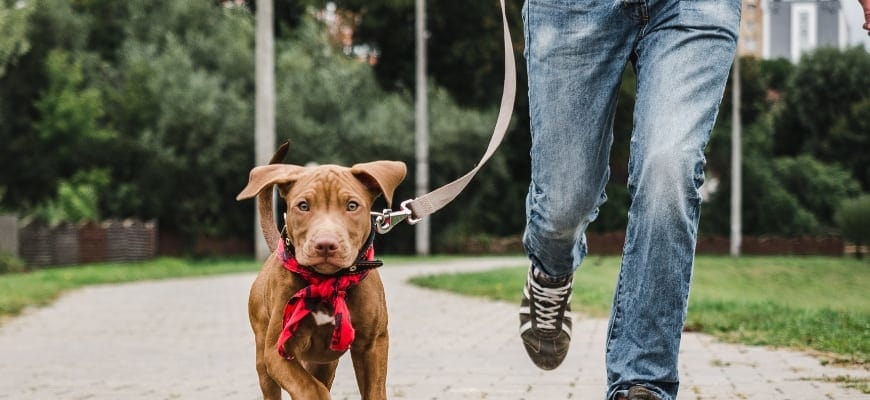
Now, with the leash hanging loose, take a tiny step forward. A loose leash is essential; you mustn’t pull your dog along behind you!
Stop and wait for your dog to follow you. Treat your pup next to your leg at his head level as soon as your pet moves toward you, even if he only takes one small step. That delicious treat reward shows your dog exactly where you want him to be.
Step 4 – Change Direction
Once your dog happily follows you in one direction, you can up the ante.
Try walking in different directions with a loose leash, remembering to treat your dog each time he follows your lead. You’ll soon find that wherever you go, your dog will be right beside you, anticipating the treat.
Practice loose leash walking for 15 to 20 minutes every day until your dog follows you.
Step 5 – One Side Only
Leash manners include having your dog walk on the side of your choice. After all, the last thing you want when you’re loose-leash walking your dog is to have him weaving in and out of your legs willy-nilly and tripping you up!
So, pick which side you want your dog to walk out and only treat him when he’s walking on that side.
Step 6 – Vary Treating
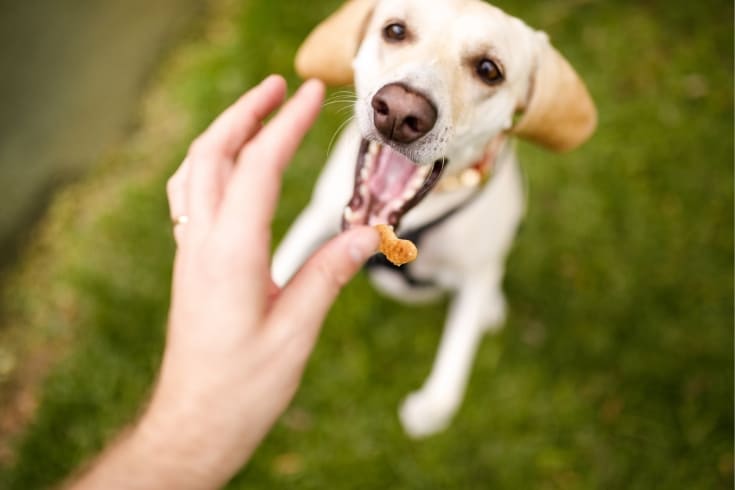
By now, your dog should be walking alongside you. Instead of treating your pet after every step, begin varying when you give your pet a treat.
For example, you might treat your dog after two steps, then four steps, then just a single step. That way, your dog will remain focused on you.
Step 7 – Change Locations
Now, it’s time to vary where you walk with your dog.
Proper leash training involves being able to walk anywhere with your pet. So, start by relocating to a different area in your home. The hallway is a good spot to choose, as the narrow layout will help to keep your dog close to you.
Go back to taking tiny steps and offering your dog a tasty treat each time he stays with you.
Ultimately, you will be able to spend periods of time walking in different rooms indoors and moving outside into your backyard with your pet, taking larger steps and offering fewer treats.
Step 8 – Take A Walk On The Wild Side!
Once your dog is walking obediently at home, you’re ready to continue his loose-leash training outside in unfamiliar places, such as your local park.
Use your 6-foot leash, and as you did in your earlier loose-leash training, take small steps and offer your dog a tasty treat each time he follows you. Again, gradually increase the number of steps you take and reduce feeding treats to your dog.
Don’t be surprised if your dog loses concentration and starts pulling, wandering away from you, or weaving around in front of you. If that happens, go back to your earlier loose-leash training or increase the frequency of treats.
Common Leash Training Problems

Problems are to be expected as part of your leash training journey, especially during early leash walks.
Pulling
Most dogs pull on their leash from time to time.
In that case, it could be that you’re not offering your dog enough treats, or the treats are not high-value enough to keep your dog’s attention.
Try using tastier treats or relocating to a spot where your pup has fewer distractions.
Lunging
Some dogs forget their manners and start lunging or attempting to chase something while on the leash.
If that happens, immediately stop walking and hold the leash as steady as you can. Don’t yank on the leash! Instead, call your dog, stamp your feet, or make some sound to distract him. When you have your dog’s attention again, give him a treat, praise him, and then start walking away. Offer your dog treats at every step until your dog settles down.
If necessary, pull your dog gently away from the distraction. Anchor the leash at your waist to create a steady leash pressure, and keep walking. Look where you’re going. That makes your dog think you’re walking toward something interesting and can help to encourage your pet to join you.
Biting Or Grabbing The Leash
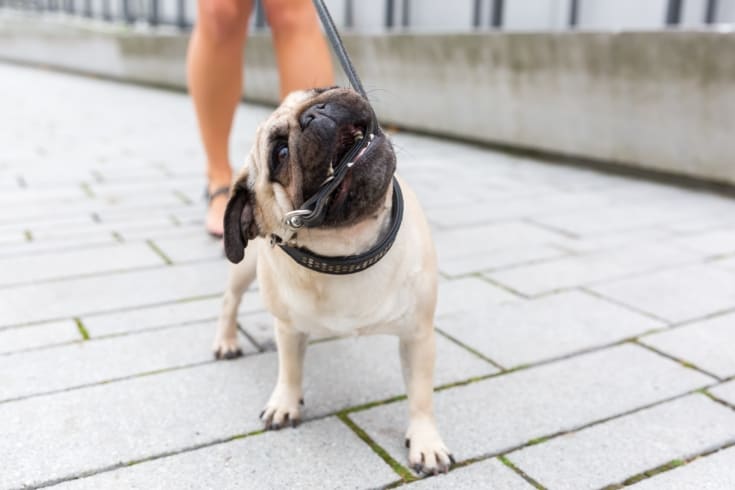
Puppies often grab or bite their leash. Don’t try to pull the leash away from your dog. That only encourages a tug-of-war situation!
Keep the leash loose so that the dog doesn’t have that desirable tug toy to grab onto. It can work well to have two leashes when you go walking. That way, if the dog grabs one leash, you can drop it and keep hold of the other leash instead.
As soon as your dog drops the leash, walk on, give him treats, and praise him. He’ll soon learn that walking politely beside you is much more fun than biting or grabbing his leash.
FAQs
In this part of our article, we answer some of the questions most often asked by pet parents looking for advice on how to leash-train their dogs.
How long does it take to leash train a dog?
The length of time it takes to leash-train a dog depends largely on the dog’s age.
You can expect a puppy to take around a month to be fully leash-trained. However, once a puppy hits his “teenage” years at around nine months of age, leash rebellion is not unheard of!
Older dogs can usually learn to walk calmly on a leash within a couple of weeks. That’s often because the dog is happy to move forward with you, whereas a young puppy will tend to sit down and refuse to move simply because he doesn’t understand what you want.
At what age should leash training start?
You can begin leash training your puppy when he’s around seven to eight weeks old.
However, young puppies have a pretty short attention span, so you’ll need plenty of patience. Keep training sessions to around a minute at a time before removing the leash. As your puppy grows older, you can make the training sessions longer.
Ten weeks of age is the sweet spot, as puppies are usually in a routine by then and can understand and follow basic commands and verbal cues.
Is it too late to leash-train my dog?
It’s never too late to teach an old dog new tricks!
However, the process of leash training might take a little longer with an older pup since you might have to retrain the dog and undo a few poor manners. Be patient, use reward-based and positive reinforcement training methods, and you’ll soon have a leash-trained canine companion.
How do I train my puppy to walk beside me on his leash?
Start by working in a small, quiet area. Take tiny steps, rewarding your puppy with a treat whenever he moves along with you.
As the penny drops, you can work in different areas of your home, taking larger steps and giving your puppy fewer training treats until he walks along beside you on his leash.
How do I teach my dog not to pull on his leash?
If your dog tends to pull on his leash, work in a small area, taking mini steps and rewarding your pet with a treat and plenty of praise when he walks beside you rather than pulling on his leash.
We recommend you use a harness with a front clip to discourage your dog from pulling.
Final Thoughts
I hope you enjoyed this article on how to leash-train your dog. If you found the information we provided helped you in your training efforts, please take a moment to share the guide with other pet parents!
Leash training takes time and patience, but it’s well worth the effort. Use positive reinforcement and reward-based methods, follow our leash training tips, and look forward to success for you and your pup!
How long did it take you to leash-train your furry friend? Share your story with other readers in the comments box below!
